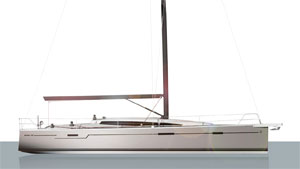Dehler is part of Hanse Yachts AG, the German conglomerate that includes Hanse, Moody and Varianta sailboats, plus Fjord and Sealine motor yachts. The economies of scale in the purchase of materials and the implementing of innovative manufacturing techniques allow the group to offer high-quality yachts at respectable prices. Dehler’s new 42 is the latest model, and it slots nicely between the 38 and 46.
Designed by Judel/Vrolijk, a firm that earned its reputation drawing TP52 racing yachts and high-performance cruiser/racers, the Dehler 42 is light and powerful. Her plumb stem mimics the look of modern race boats, but more importantly it extends the waterline, which increases top speed. Although the after sections of the hull clear the water in a graceful arc when the boat is bolt upright, she’ll gain waterline (immersing the transom) at her optimum angle of heel.
In keeping with the need for speed, the 42 has a fairly shallow underbody. Its fine entry will split the seas, and her elliptical sections further aft ought to give her an easy motion for such a lightweight boat. The standard model’s fin keel and torpedo-shaped ballast bulb help create a friendly righting movement.
As is common nowadays, the 42 shows a generous amount of freeboard throughout her overall length. This gives her a substantial amount of reserve buoyancy if she’s ever knocked onto her beam end, and it provides the voluminous interior that modern cruising sailors demand. This style can seem bulky when you stand next to it at a boat show, but the subtle sweep in the sheerline lessens that impression when you see the boat underway.
Dehler offers a couple of interior arrangement plans. The A1-B1-C1 option has a single head/shower on the port side at the bottom of the companionway. The L-shaped galley is opposite, situated between the after bulkhead and the U-shaped settee in the saloon. Immediately abaft the galley is a double stateroom with one hanging locker. Her navigation station on the port side has an instrument panel outboard, and the desk separates the area from a small settee forward.
 |
|
A bulbed keel and spade rudder add to the Dehler’s performance capabilities. |
|
Courtesy Dehler |
The Dehler 42’s beam grows to its maximum at the area that houses the head, galley and engine room, so all of the heavy stuff sits over the hull’s longitudinal center of buoyancy. This reduces pitching in head seas. She carries a big percentage of her maximum beam all the way aft, allowing for the after stateroom and, in this layout, a large stowage area. The propane tanks live there, and an island V-berth and two hanging lockers fill the pointy end.
Option A1-B1-C2 has a mirror-image double stateroom aft on the port side and substitutes a head — with wash basin — for the starboard hanging locker in the forward cabin. This plan would serve well in the charter industry.
Furniture in both arrangements is mahogany, and the cabin soles are Australian acacia, a blonde wood that will brighten the interior. Options are American cherry or teak for the furniture, and Noce nero (very dark) or teak and holly for the cabin soles. Overhead hatches in the trunk cabin and opening windows along the sides ventilate and light the accommodations.
Her standard rig is a conventional 7/8 fractional triangle on aluminum spars managed by Selden winches and hardware. The optional carbon-fiber rig is a bit taller but is also a fractional triangle. Swept spreaders keep the mast in column, eliminating the need for running backstays. The competition version of the 42 has a fixed carbon-fiber bowsprit for flying the Code Zero or gennaker. Harken sail-handling gear and hardware also are optional.
Having so much beam at the after end of the boat has allowed Dehler to give the 42 a spacious twin-wheel helm, separated from the main part of the cockpit by the mainsheet traveler. The halyard winches live on the trunk cabin, flanking the companionway. Mainsheet winches are mounted just forward of the wheels, and the headsail winches are just a short reach further forward. Although the traveler spans the cockpit sole, moving forward and aft between the sections of the cockpit should be easy.
 |
|
A modern, V-shaped boom makes for easier sail-handling. |
|
Courtesy Dehler |
Dehler builds the 42 via the resin infusion method, using fiberglass over foam coring set in vinylester resin. An internal carbon reinforcement grid molded into the bottom of the hull increases stiffness and distributes the loads from the rig and keel over a large area.
In addition to the standard keel and the deeper competition keel, Dehler offers a shoal-draft keel, which has a slightly longer chord length than the other options and is not compatible with the deep-competition keel.
Dehler plans to introduce the 42 this coming January at “boot 2016” in Dusseldorf, Germany.
Dennis Caprio is a freelance writer based in Newport, R.I.
 |

